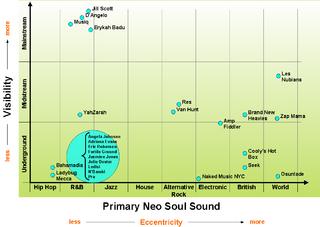Neo Soul Lexicon: The Artist Sound/Visibility Rating
By Sean
Editor-in-Chief, Neo Soul Today
This fifth installment of the Neo Soul Lexicon Series is devoted to establishing a quick and easy-to-understand rating system for neo soul listeners to use when searching for and learning about neo soul artists. This rating system is called the Artist Sound/Visibility Rating.
For neo soul listeners, the Artist Sound/Visibility Rating is intended to:
1. Enable us to quickly identify neo soul artists whose primary sound matches our individual tastes
2. Enable us to quickly get a sense of how accessible a neo soul artist is through mainstream online and brick-and-mortar record stores, television, newspapers, periodicals, websites, and other channels
3. Assist us with making informed purchasing decisions
4. Give us the highest likelihood of attending live performances that we will enjoy
For neo soul artists, (based on listener consensus) the Artist/Sound Visibility Rating is intended to:
1. Give you an impression of how your overall sound is perceived by neo soul listeners
2. Give you an impression of how accessible you are through mainstream online and brick-and-mortar record stores, television, newspapers, periodicals, websites, and other channels
For recording industry entities, the Artist/Sound Visibility Rating is intended to:
1. Give you an impression of how your neo soul artists' overall sounds are perceived by neo soul listeners
2. Give you an impression of how accessible your neo soul artists are through mainstream online and brick-and-mortar record stores, television, newspapers, periodicals, websites, and other channels
3. Allow you to streamline your neo soul artists' offerings to the appropriate market segments
Vocabulary Prerequisites
Before describing the Artist Sound/Visibility Rating and to prevent any confusion or misinterpretation, it is worthwhile for you to know what we mean by the following terms: neo soul, neo soul artist, contributing artist, sound, and visibility. When using the term “artist” in this installment, we are referring to neo soul artists as opposed to contributing artists.
The Problem: Discovering New Neo Soul Artists is Time-Consuming
Although audio tools such as niche Internet radio stations, track-sampling on the web, and in-store CD listening have taken some of the guesswork out of the discovery process, it can still be quite frustrating when you can't find anything. Another popular route to discover potential artist matches for your taste includes reading articles, reviews, and interviews at authoritative sources on the web such as Neo Soul Today. However, the truth is that it is frustrating to read review upon review and interview upon interview just to discover that a particular neo soul artist's sound and style does not agree with your taste. Then you have to start the process all over again.
The Solution: The Artist Sound/Visibility Rating
In terms of reading content on the Internet, there must be a quicker and easier way to get an idea of whether you'll like an artist you discover before investing the time in reading reviews, interviews, or artist profiles. The solution is the Artist Sound/Visibility Rating.
The Artist Sound/Visibility Rating (or the Artist S/V Rating) is a tool created here at Neo Soul Today -- for use by all -- for quickly and easily getting a sense of a neo soul artist's sound and visibility characteristics. Sound and visibility are the two key attributes that capture the basic essence of a neo soul artist.
Sound is the essential attribute that describes the auditory characteristics of neo soul songs, artists, and the artform itself. In this context, we're interested in a neo soul artist's primary sound. The 8 sound categories of neo soul in order of increasing eccentricity are hip hop, R&B, jazz, house, alternative rock, electronic, British, and world. This attribute is useful for evaluating whether an artist's primary sound is one that you even like.
Visibility is the essential attribute that describes how accessible a neo soul artist is to listeners, the media, and the general public. The three artist visibility levels in order of decreasing visibility are mainstream, midstream, and underground. This attribute is useful for evaluating not only how easy it is to find an artist's music, but also to get a sense of the type of audience an artist is reaching at a given point in time.
(Visibility is an interesting attribute. In order to keep this topic focused, I expound on why in a comment if you'd like to read more.)
The figure below graphically illustrates examples of the Sound/Visibility Ratings for some neo soul artists. These are only examples and do not represent all neo soul artists as there are obviously many more.
Other Examples of Artist Sound/Visibility Ratings
India.Aire (R&B/Mainstream)
Goapele (R&B/Underground)
Antoinique (Jazz/Underground)
Maysa (Jazz/Midstream)
Gaelle (Electronic/Underground)
At Neo Soul Today, you will see Artist Sound/Visibility Ratings used frequently; especially in artist profiles, opinion pieces, album reviews, and interviews.
As always, we welcome your comments. What do you believe the S/V Rating is for other neo soul artists not mentioned here?




1 Comments:
Visibility is an interesting attribute. Some neo soul artists strive to maintain their current level of accessibility to the mainstream. Specifically, these artists choose to remain underground and consider it the best way to independently express themselves and cater to the audience that most closely identifies with that independent expression. Other artists do not necessarily strive to maintain their current level of accesibility to the mainstream. For example, some artists reaching an underground audience would be more than happy to crossover into the midstream or mainstream (see YahZarah). Likewise, many artists reaching a mainstream audience, for example, would be more than happy to retreat back to the underground (see Erykah Badu). And then there are those artists whose visibility level may change due to market forces rather than due to their own desires. For example, whether or not Leela James wants the hype she's receiving, the market is demanding the product she's putting out there.
Post a Comment
<< Home